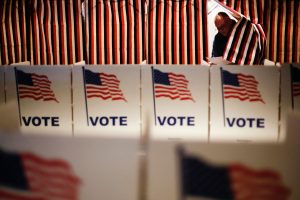Polling stations opened at 8 a.m. in Iran today, May 19, as voters will choose whether to give President Hassan Rouhani a second term in office or elect his challenger, Ebrahim Raisi.
Rouhani has framed the election as a referendum not only on his policies but Iran’s relationship with the west. The incumbent president has been under pressure from conservative critics and those who say the 2015 nuclear deal has not yielded the promised benefits for Iranians.
Polls are set to close at 6 p.m. (13:30 GMT) but will stay open later if necessary to accommodate the nation’s 56 million eligible voters. If no candidate wins a simple majority (50 percent plus 1) of the vote, the top two candidates will go into a runoff.
#Photo #IranElections2017
Presidential candidate #HashemiTaba stands in queue like any other citizen waiting to cast his vote pic.twitter.com/xYmH2QfIlM
— Iran (@Iran) May 19, 2017
The candidates
Rouhani and Raisi were two of five candidates approved out of the 1,636 who registered to run in the May 19 election.
Rouhani was elected in 2013 and his administration is made of a mix of moderates and reformist party politicians.
Raisi represents the Islamic Revolution Forces Popular Front (Jebha-ye Mardomi-ye Niruha-ye Enqelab-e Eslami), a new umbrella group of Principlists, the country’s mainstream conservatives.
Both Rouhani & Raisi say #IranElections2017 results needs be respected, in effect echoing #Iran Khamenei's call for law & order
— Ladane Nasseri (@LadaneNasseri) May 19, 2017
The Guardian Council also approved Rouhani’s Vice President Eshagh Jahangiri; Tehran mayor Mohammad Baqer Ghalibaf; former culture minister Mostafa Mirsalim; and reformist politician Mostafa Hashemitaba.
Voter turnout was reported to be high in many areas of the capital Tehran on Friday afternoon. Counting begins as soon as the polls close, but the first results aren’t expected until early Saturday.
4pm in Tehran and I'm in line to cast my vote; at least 200 people are ahead of me
#IranElections2017
— Mahdi Taghizadeh (@mahdi) May 19, 2017
One of my favorite photos of the #IranElections2017 so far pic.twitter.com/0afQDGljfK
— Feri فری (@FeriFilter) May 19, 2017
The longest lines I have ever seen in 15 years of reporting here. This is Husseiniye Ershad where most foreign reporters and state tv are. pic.twitter.com/2W3BfgIdSJ
— Thomas Erdbrink (@ThomasErdbrink) May 19, 2017
Ebrahim Raisi
Raisi, who is running for the first time, is a member of the Assembly of Experts (Majles-e Khobregan-e Rahbari), the body who will choose Iran’s next Supreme Leader after Ayatollah Ali Khamenei.
There are some who believe the political hardliner could be in the running himself to replace Khamenei.
Raisi has accused Rouhani of undermining Iran’s interests in the 2015 nuclear deal, for which some see little economic return domestically. Raisi promised to create 6 million jobs in his first term. He said in a presidential debate he represents the labor class and “those who have a lot to say but have no microphone.”
This billboard along Tehran's Hemmat highway says "the president should be popular and workaholic." pic.twitter.com/G4UIDiBqSY
— Thomas Erdbrink (@ThomasErdbrink) May 19, 2017
On May 15, Tehran Mayor Mohammad Ghalibaf dropped out of the race to back Raisi. The Guardian noted that Ghalibaf got about 6 million votes in the 2013 presidential election, which Rouhani won with 18.6 million votes.
Hassan Rouhani
Rouhani ran on a moderate reformist platform in the 2013 election, following Mahmoud Ahmadinejad’s two terms that saw Iran become more isolated and less tolerant of dissent. Ahmadinejad’s 2009 re-election was seen by many as fraudulent his announced victory sparked large protests in Iran and around the world.
During Rouhani’s first term, his foreign minister Javad Zarif secured a deal with the “E3+3” or “P5+1” (the five permanent members of the UN Security Council and Germany) that saw a rollback of western-imposed sanctions in exchange for assurances that the country’s nuclear program will not be weaponized.

Rouhani’s administration has manged to curb economic inflation, which was over 40 percent when he took office, but unemployment remains high – especially for young people who are likely his biggest supporters.
He can also count on supporters of other reformist candidates, if he can get them to turn out. Historically, reformist politicans have won with a higher voter turnout, and Rouhani won only 50.7 percent of the vote in 2013 when turnout topped 70 percent.
Media cant publish about Mohammad Khatami,the popular former president,but this is how 100s of cameras capture him voting #IranElections2017 pic.twitter.com/xrCWzEjztD
— Tara Sepehri Far (@sepehrifar) May 19, 2017
"Grandpa, who are u voting for?"
"Khatami."
"But Khatami isnt on the ballot."
"I'm writing Rouhani, but I mean Khatami."#IranElections2017— Sidewalk Goats (@pedestrian) May 18, 2017
Eligible voters among the 5 million Iranians living abroad can vote in about 130 countries, according to the foreign ministry. Despite the lack of diplomatic relations between the two countries, Iranians in the United States can vote through the Iran interests section at the embassy of Pakistan.
Ottawa declined to allow Iran to set up polling stations for Iranians in Canada. The two countries are still working to resume diplomatic ties, which were cut in 2012.


